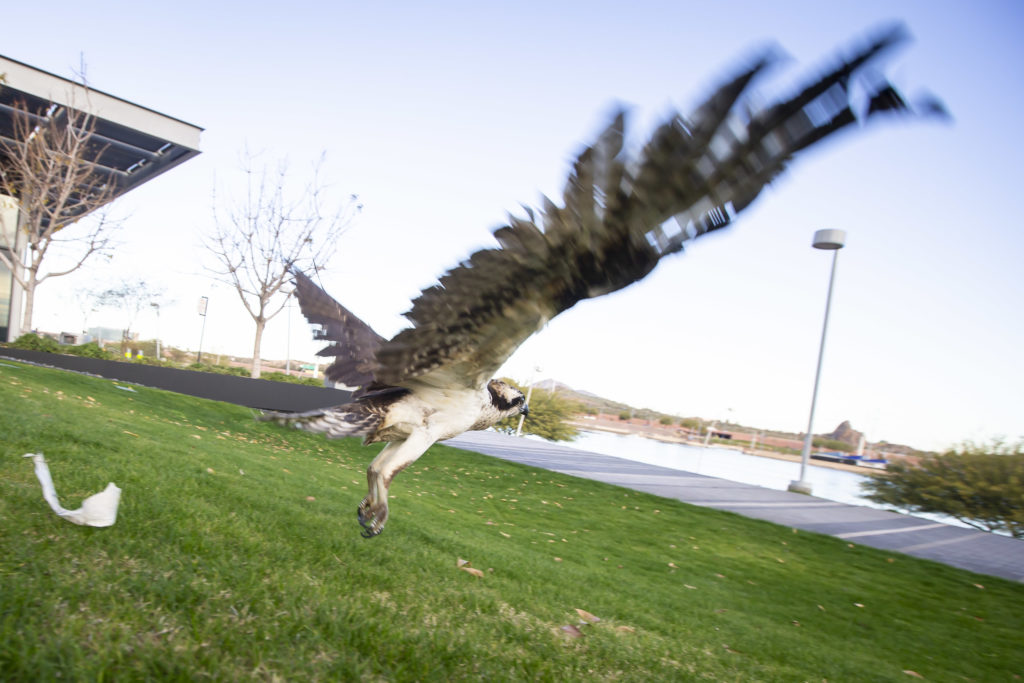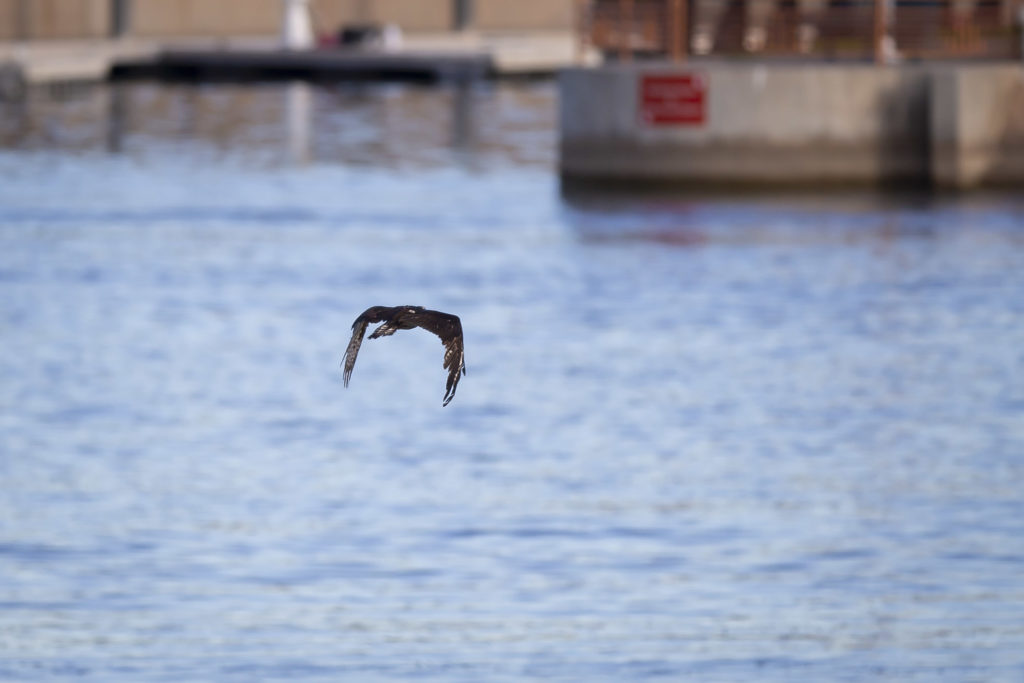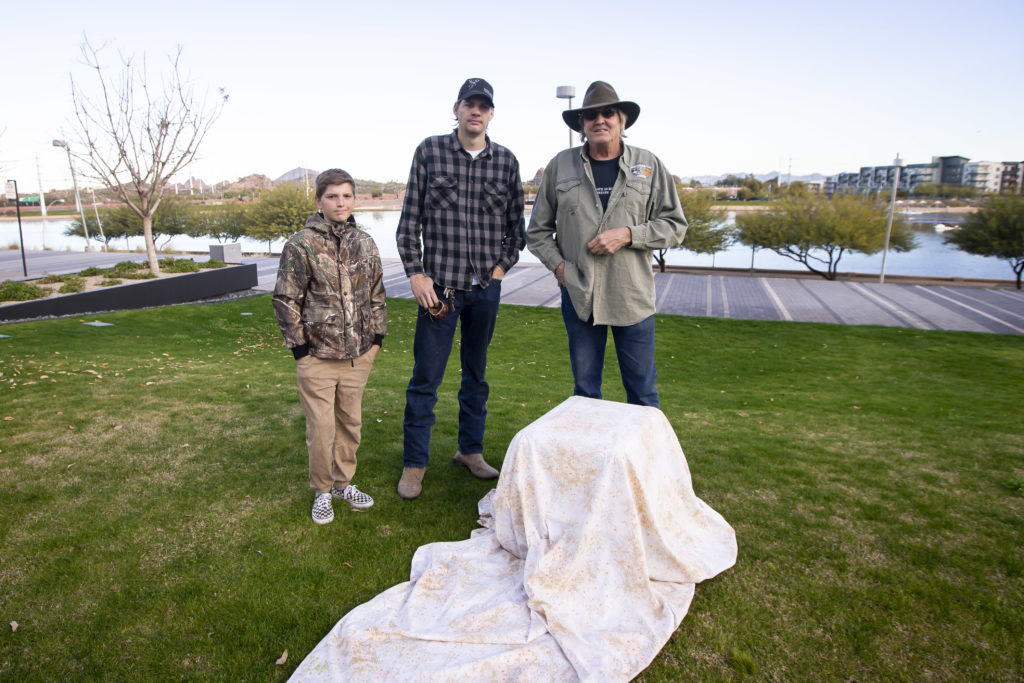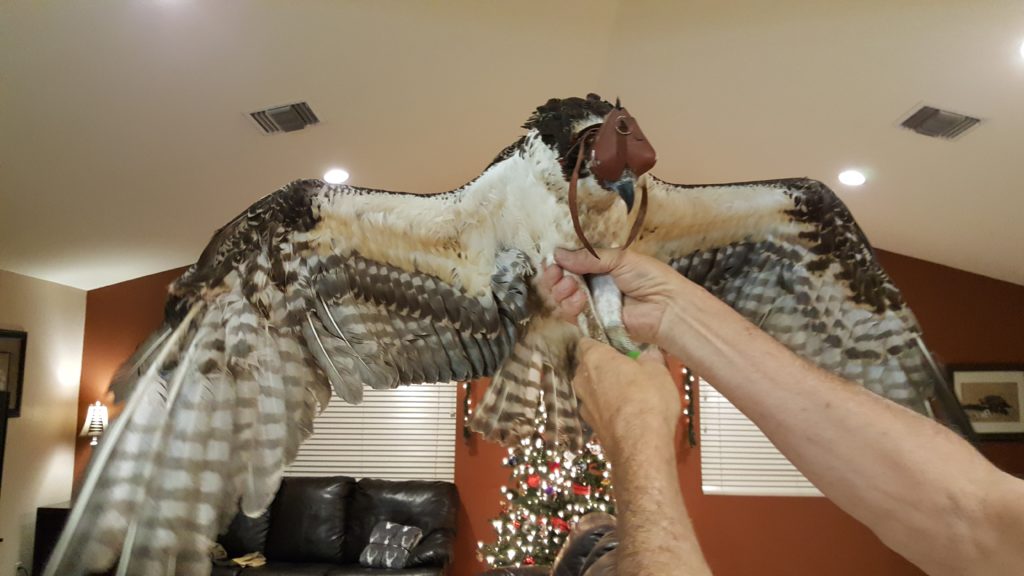
By Sammie Ann Wicks
The hatchet-like head, thrust down to peer below the massive, flailing wings, outstretched feet pressed tight against the densely feathered body, talons clinched inward to slice through the wind, wheeling, roiling, pitching slowly downward.
The clear, implacable eye, vigilant, merciless, relentlessly scanning the surface of the shimmering water below.
Then it happens…happens in an instant: the precipitous downward plunge, wings tucked in for speed, feet first now, talons stretched wide open to clutch the astonished prey in an explosion of water, fish and fowl, all but wings submerged.
Only a few labored wing-beats later, the victor and its screeching chicks tear at the bloody carcass in their lonely, wind-swept nest atop branches high as a city building.
It is the king of all fishing raptors, the legendary Osprey, Pandion Haliaetus, observed and named by Linnaeus, a bird so unique in its traits and behavior that it occupies its own taxonomical genus (Pandion) and family (Pandionidae).
Ospreys are monogamous, and mate for life, traits which place them in the annals of myth and legend as symbols of loyalty and constancy.
As exotic to the American Southwest as it might seem, and as a raptor far more rare than the ubiquitous red-tailed Hawks that fill the skies of Arizona, we here in Tempe needn’t travel far, though, to glimpse this fabled creature, for Town Lake is now home to one.
Or very nearly wasn’thome to one, but for a genuine stroke of avian luck.
“This poor little guy flew into some power lines, we think, and was electrocuted; but luckily, it was by the static kind of electrical charge—had it been a grounded hit, it would’ve been all over for him.”
 ‘A fable himself’
‘A fable himself’
The speaker, the very embodiment of human-mediated luck for Town Lake’s young osprey, is a kind of fable himself: A lover and defender of raptors since his 12th birthday more than 50 years ago when he and his surgeon father found an injured hawk while hunting, master falconer and eagle expert Jerry Ostwinkle was present in the Tempe area at the exact time the bird was struck, meaning this beautiful bird will live to fly and hunt again, thriving in the wild, where he belongs.
As luck would have it, this youngster found himself with an injury that, although significant, was non-fatal, and fate had it that he was injured in close proximity to a healer with skills few people nationally can claim.
The first challenge the master falconer faced was obtaining a viable wing to replace the young Osprey’s badly injured one.
“We don’t see that many Ospreys here, but luckily, we have contacts all over the country, and that path led us to Minnesota, where they have an abundance of ospreys like we here have an abundance of red-tailed hawks,” Ostwinkle recounts.
“So they sent me the right primary of an osprey that had been killed.”
Ostwinkle believes the presence of the juvenile male means his parent, or parents, are nearby.
“We have ospreys living on Town Lake, and it would seem likely they could be the family he comes from,” Ostwinkle notes.
Ospreys are found the world over, and are drawn to lakes and other waterways where they can find and consume the fresh fish they have come to favor.
After the injured bird at Town Lake was discovered, Ostwinkle moved quickly to start the complicated rehabilitation procedure which, to succeed, requires both time and unparalleled attention to detail.
“All of this bird’s primaries were completely buzzed off by the static burn, and that meant we had to dig out all the dead tissue on his own wing, and then let it grow back out because the area has to have a blood supply,” Ostwinkle explains. Attaching the viable right wing obtained from Minnesota to the injured bird was Ostwinkle’s next challenge.
Ostwinkle likens feather replacement to “putting hair extensions on a person. But with a bird, the feathers have to be lined up perfectly for the wing to function like it should.”
A process called “imping,” rehabilitation of injured birds, is a daunting skill set few have, and Ostwinkle complains many who attempt the delicate procedures without the proper knowledge or depth of experience can do more harm than good.
“Some of the so-called rehab is harmful—almost tortuous for the birds, and unskilled people need to stop attempting it,” Ostwinkle opines. “It gets bad enough that things they’ve done will result in the bird’s death once it’s back out in the wild.”
The skill-set requirement is what governs who Ostwinkle says he is willing to work with.

An elite cohort
“I’m a master falconer, there are only eleven master falconers in the entire country, and everybody in my group is a master falconer. It’s because of this that we have no volunteers. You have to know what you’re doing. I wouldn’t have it any other way.”
Falconry is an ancient vocation, and Ostwinkle says he takes special pride in being part of its heritage.
“Where my group is concerned, we practice well-honed techniques that have been in use during more than 3,000 years of falconing’s history, and we revere our tradition.”
In the same way he respects his art’s traditions, Ostwinkle’s regard for the birds he has worked with comes from a healthy respect for their power. “I work with eagles; few do, and there’s a reason. You must always be aware of what this bird is capable of. They’re highly intelligent, and can weigh 10 pounds. Their talons are four inches long, and they can assert them with upwards of 3,000 pounds of pressure. Make no mistake—they can kill a man in an instant.”
For all his years of experience and passionate commitment to the welfare of raptors, though, Ostwinkle’s own approach to his work is curiously detached, born of a deeply realistic knowledge of wild things.
“Look. These birds aren’t pets. My job is to put them back in the wild immediately, to not get attached,” he declares, describing his method as completely ‘hands off.’ The problem with being a falconer is knowing that when you’re with a bird, it might be the last day you’ll ever see it. Tomorrow, it could be hit by a car, or it might run into a fence, or something else.”
In the higher interest of the bird’s own welfare, Ostwinkle’s center strictly abides by its founder’s dictum.
“A wild bird shouldn’t even see a person; all we do is feed it. Because of that, we don’t allow people on the property. You have to accept that you can’t have an emotional attachment to wild birds, because inevitably, you’re going to lose them.”
Interesting words for a man who has lived his entire life in devoted service to feathered creatures in their wild habitat, a man whose care for them still shows through…a bird advocate who once wore a .45 pistol to greet federal wildlife agents who had come to take possession of a golden eagle he had rescued from a neighborhood swimming pool. (He didn’t interfere with the agents, but insisted they transport the bird properly.)
Detachment or passionate advocacy, or their artful combination as tools of avian science, Ostwinkle’s approach ends up being one of pure practicality, with the bird’s natural traits and highest good as the driving force.
 Native ethic
Native ethic
“In the end, whatever its injuries have been, to go back in the wild, raptors have to be able to hunt. To do that, they must have a strong flight capability and be able to spot and capture prey.
“If a bird’s injuries haven’t been healed, or it’s been improperly rehabilitated, it becomes weak, and will be preyed upon by stronger individuals. Obviously, it can’t survive in the wild like that.”
That philosophical viewpoint moves Ostwinkle to make a central part of his center’s mission educating the public and other animal advocates about how to live near wild raptors, a mission that, in its conduct, puts forth an overarching native ethic: caring for raptors ultimately means caring for their natural environs.
“Birds of prey are important to the environment and to all creatures on this earth,” concludes Ostwinkle, “and their welfare in turn depends on a well- balanced eco-system.”

